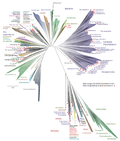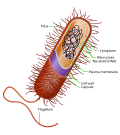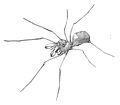Archaea (/ɑːrˈkiːə/ ar-KEE-ə) is a domain of organisms. Traditionally, Archaea only included its prokaryotic members, but this sense has been found to...
156 KB (16,531 words) - 19:15, 16 October 2024
Archaea is a domain of single-celled organisms. Archaea or archea may also refer to: Archaea (spider), an extinct genus of Archaeidae Archaea (journal)...
515 bytes (81 words) - 07:48, 6 September 2023
Domain (biology) (section Archaea)
of either three domains, Archaea, Bacteria, and Eukarya, or two domains, Archaea and Bacteria, with Eukarya included in Archaea. In the three-domain model...
12 KB (1,293 words) - 00:44, 25 July 2024
Three-domain system (redirect from Towards a natural system of organisms: proposal for the domains Archaea, Bacteria, and Eucarya)
classification system that groups all cellular life into three domains, namely Archaea, Bacteria and Eukarya, introduced by Carl Woese, Otto Kandler and Mark...
15 KB (1,602 words) - 17:54, 14 June 2024
Asgard or Asgardarchaeota is a proposed superphylum belonging to the domain Archaea that contain eukaryotic signature proteins. It appears that the eukaryotes...
33 KB (2,841 words) - 08:21, 10 October 2024
Archaea, one of the three domains of life, are a highly diverse group of prokaryotes that include a number of extremophiles. One of these extremophiles...
12 KB (1,462 words) - 15:44, 20 January 2024
the Asgard archaea, and are closely related to the Heimdallarchaeia. This implies that there are only two domains of life, Bacteria and Archaea, with eukaryotes...
61 KB (6,102 words) - 08:24, 10 October 2024
are classified into two domains, Bacteria and Archaea. It emerged from development of knowledge of archaea diversity and challenges the widely accepted...
42 KB (4,600 words) - 05:53, 13 September 2024
Biology (section Bacteria and Archaea)
Eukaryota. Archaea are further divided into multiple recognized phyla. Archaea and bacteria are generally similar in size and shape, although a few archaea have...
133 KB (13,837 words) - 12:48, 11 October 2024
prokaryotes are divided into two domains: Bacteria (formerly Eubacteria) and Archaea (formerly Archaebacteria). Organisms with nuclei are placed in a third...
44 KB (4,782 words) - 21:35, 2 October 2024
Microorganism (section Archaea)
domains of life, they can be extremely diverse. Two of the three domains, Archaea and Bacteria, only contain microorganisms. The third domain, Eukaryota...
74 KB (7,752 words) - 15:36, 7 October 2024
Archaea is an extinct genus of spiders in the family Archaeidae. As of October 2016[update], four species are placed (or possibly placed) in the genus...
5 KB (579 words) - 04:25, 15 September 2023
Orania archaea is a species of sea snail, a marine gastropod mollusk in the family Muricidae, the murex snails or rock snails. Subspecies Orania archaea archaea...
2 KB (161 words) - 10:56, 24 January 2023
Marine prokaryotes (redirect from Marine archaea)
Cell wall Capsule Pili Marine prokaryotes are marine bacteria and marine archaea. They are defined by their habitat as prokaryotes that live in marine environments...
136 KB (12,690 words) - 04:54, 10 October 2024
have used a system of six kingdoms (Animalia, Plantae, Fungi, Protista, Archaea/Archaebacteria, and Bacteria or Eubacteria), while textbooks in other parts...
74 KB (4,820 words) - 12:31, 14 October 2024
Unicellular organism (section Archaea)
Most prokaryotes are unicellular and are classified into bacteria and archaea. Many eukaryotes are multicellular, but some are unicellular such as protozoa...
33 KB (3,362 words) - 20:27, 16 October 2024
Outline of life forms (section Archaea)
life forms. No form of extraterrestrial life has yet been discovered. Archaea – a domain of single-celled microorganisms, morphologically similar to...
11 KB (767 words) - 16:50, 20 July 2024
Methanogen (redirect from Methanogenic archaea)
Methanogens are anaerobic archaea that produce methane as a byproduct of their energy metabolism, i.e., catabolism. Methane production, or methanogenesis...
66 KB (7,445 words) - 02:24, 13 October 2024
ancient common ancestor. These evolutionary domains are called Bacteria and Archaea. The word bacteria is the plural of the Neo-Latin bacterium, which is the...
143 KB (15,532 words) - 00:56, 20 September 2024
ancestral cell from which the three domains of life, the Bacteria, the Archaea, and the Eukarya originated. The cell had a lipid bilayer; it possessed...
63 KB (6,605 words) - 14:10, 7 October 2024
Nitrification (redirect from Ammonia-oxidizing archaea)
aerobic process performed by small groups of autotrophic bacteria and archaea. The process of nitrification begins with the first stage of ammonia oxidation...
42 KB (4,993 words) - 21:37, 13 October 2024
DPANN (redirect from Ultra-small archaea)
DPANN is a superphylum of Archaea first proposed in 2013. Many members show novel signs of horizontal gene transfer from other domains of life. They are...
28 KB (1,954 words) - 00:05, 17 October 2024
One main characteristic of the three-domain method is the separation of Archaea and Bacteria, previously grouped into the single kingdom Bacteria (a kingdom...
69 KB (6,803 words) - 08:10, 11 September 2024
of the two domains Archaea and Eukaryota, coined by Thomas Cavalier-Smith in 2002. Its name reflects the hypothesis that both archaea and eukaryotes evolved...
13 KB (1,424 words) - 08:38, 10 October 2024
Bergey's Manual of Systematic Bacteriology (redirect from Bergey's Manual of Systematics of Archaea and Bacteria)
more empirical in recent years. The Taxonomic Outline of Bacteria and Archaea is a derived publication indexing taxon names from version two of the manual...
15 KB (1,752 words) - 05:52, 15 October 2024
plants (also including algae and fungi) and prokaryotes (bacteria and archaea), is Latin and binomial in form; this contrasts with common or vernacular...
27 KB (3,079 words) - 11:08, 24 April 2024
The Surprising Archaea: Discovering Another Domain of Life is a popular science book written about the domain Archaea. It was written by John L. Howland...
1 KB (93 words) - 23:19, 4 June 2021
Pink lake (section Bacteria/archaea)
as Dunaliella salina, usually in conjunction with specific bacteria and archaea, which may vary from lake to lake. The most common archaeon is Halobacterium...
13 KB (1,372 words) - 08:15, 12 September 2024
Eocyte hypothesis (category Archaea biology)
prokaryotes called eocytes (later classified as Thermoproteota, a group of archaea). After his team at the University of California, Los Angeles discovered...
42 KB (4,790 words) - 18:26, 14 September 2024



















